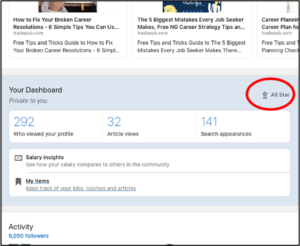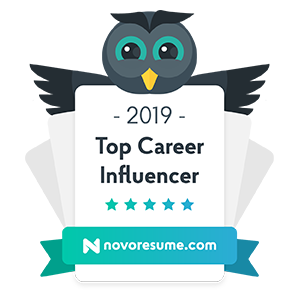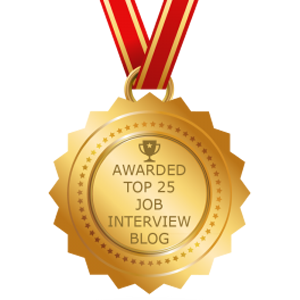Updated: April, 2021
LinkedIn is one of the most powerful job search tools you can use for landing a job. However you have to know how to use it in order for it to be effective in your job search. Since LinkedIn uses Search Engine Optimization (SEO) to deliver search results to the searcher, LinkedIn profile SEO is an area in which you will need to be optimized. In this blog post we’ll give you a crash course in LinkedIn SEO including tips on how to boost your LinkedIn profile in search results.
If there’s one lesson that stands out from my experience as an Executive Recruiter, it is that of the importance of being optimized on LinkedIn. It’s not enough to just be “on” LinkedIn. You must be “optimized” on LinkedIn in order to make this powerful career platform work for you. Since LinkedIn optimization is the goal, you’ll need to understand the strategies to use for LinkedIn AND professional brand optimization.
Is LinkedIn Profile Optimization Necessary for You?
If you’re not completely sold on the value of LinkedIn for your career, I want to give you my professional opinion on the matter. To be absolutely clear: LinkedIn profile optimization is necessary for all professionals regardless of industry, role, level or status. Yes, even passive job seekers need to be LinkedIn optimized. LinkedIn is far more important than your resume so the time is NOW to focus on making it work well. If you don’t spend time getting your LinkedIn profile in order, you will absolutely miss out on future opportunities. This is a fact.
The Bare Minimum Requirements for Your LinkedIn Profile
The first step in LinkedIn profile optimization is meeting LinkedIn’s requirement for profile optimization. LinkedIn essentially sets the rules for how to use their platform. Therefore it’s to your benefit to play by their rules. Achieving “All-Star” status with your LinkedIn profile is the first step towards optimization. LinkedIn created “All-Star” status as a way to let its users know whether or not their profiles meet the bare minimum profile requirement. I wrote a blog post on how to achieve LinkedIn “All-Star” status which will tell you everything you need to know about achieving this status. Start by implementing this on your profile.
How to Take Your LinkedIn Profile to the Next Level
After you have achieved “All-Star” status, focus on search engine optimization (SEO) basics. Once you get beyond the basics you can use these 9 LinkedIn SEO hacks to take it to the next level. However for now, we just want to start with the basics. Making sure your profile can be found on LinkedIn is super important because you are one of 700 MILLION people vying for attention. Think of Google or any search engine where we know our needle in the haystack item is just a search away. You, essentially, are an online product on LinkedIn just like the items you search for on Amazon. You are a professional brand and your professional brand is no good unless you are searchable. On LinkedIn (and any search engine), this requires basic knowledge of SEO.
“I’m already through my first interview with a company that found me 2 days after I updated my new LinkedIn profile.”
– TOM, OPERATIONS EXECUTIVE & LINKEDIN MAKEOVER CLIENT
What is SEO?
SEO stands for “search engine optimization” or simply: the art of being found amongst all the internet clutter. It’s what determines where you appear or rank in the search results. Are you on page one of the results, toward the top? (YAY)! OR are you on page 35? If you’re showing up anywhere beyond the 1st or 2nd page, you may never be found. To give you some perspective of why branding and SEO are important: a LinkedIn search for keyword “Accountant” produces over 6 MILLION results!!! So if you’re an Accountant, you need to figure out your unique value proposition and brand yourself accordingly! I should mention, it’s not just Accountants. This goes for everyone. If you don’t believe me, do a LinkedIn search for your job title.
Why is SEO important for LinkedIn?
SEO is super important for LinkedIn because if you think about it – the only purpose for being on LinkedIn is to find or be found. And quite honestly, when it comes to the job search, the only thing better than having to apply for a new job is being found by a hiring manager. This is by far the easiest way to land a job.
How does SEO work on LinkedIn?
Where you rank in LinkedIn search results is based on your relevancy to the searcher. This means even if you and I performed the exact same keyword search, our results would be entirely different. So being relevant to many searchers on LinkedIn is important.
What can you do to boost your LinkedIn relevance?
Knowing how to be relevant on LinkedIn is important for SEO and is also fairly simple. Even if you don’t understand SEO in full, there are 4 simple steps to becoming more relevant in your LinkedIn profile SEO.
1. Make Your LinkedIn Profile 100% Complete
You’ll know you have a complete profile if your status is “All-Star.” You can find instructions for how to reach “All-Star” status here. As of 2021 when this screenshot was taken, your profile status will show up on your dashboard between the “About” section and the “Activity” section. It’s possible that your profile completeness status section may look different or be located in another part of the profile. LinkedIn tends to make interface updates from time to time. If it’s not exactly in this location on your profile, simply look around your profile editing page and you should find it.
2. Add Skills
Skills can be added towards the bottom of your LinkedIn profile and are important because many people search for LinkedIn members using skills keywords. While you can add as many skills as you want it’s important to have a minimum of 3 (for profile completeness). It’s also important to keep your most valued skills towards the top of the list as these will be the skills that are pushed out to your contacts for endorsements. The skills with the greatest number of endorsements will make you more relevant when searched by the particular skill keyword. If you’re not sure which skills to include, use job descriptions to guide your skills selection. This will ensure you are positioned as someone relevant to your target job.
Watch Noelle’s LinkedIn Profile Writing Course Now!
3. Connect to a Lot of People (2nd and 3rd Degree Connections Count)
When searching for contacts based on keywords, part of the way results are ranked is associated with the degree of connectivity to the searcher. This is where that relevancy factor comes into play. You must be relevant in order to appear in their searches. The way to be relevant is by being a 1st, 2nd, or 3rd degree connection with the searcher. Therefore if you are a first degree connection with someone, you will likely appear higher up in their search results. The same goes for 2nd and 3rd degree connections. The larger your network, the more relevant you become. Therefore, the best strategy is to to connect and keep on connecting so you can grow your network as large as possible. This will make you more relevant to more hiring managers, recruiters, key networking contacts, etc. And yes, you should be connecting to strangers. As I tell my workshop attendees, “you don’t have to marry them, just connect to them on LinkedIn!”
4. Use Standard Job Titles
Last but not least, you should use standard job titles in the “Experience” section of your profile. Similar to skills keywords, title keywords are also a popular way to search for LinkedIn members. For example, if you have a standard title like “Accountant” it’s likely you will appear when another member searches keyword: “Accountant.” However if you have a less standard title like some of the titles used at startups, it’s unlikely that the average LinkedIn member will know to search for your specific title. For example I just came across someone at a newer company, with the title, “Customer Coach.” Now it’s likely they are serving the role of Customer Service or Support. If I were to try and find someone to recruit for my Customer Service team, and this Customer Coach was the absolute perfect fit, I might never find her profile given the title variation.
So take a moment to brush up your relevance factor and rest assured that you’ll be on your way to a more optimized profile. If you’d like to take your LinkedIn profile SEO to the next level, you will definitely want to check out these 9 profile SEO hacks!
If you’re hoping to improve your LinkedIn strategy and land a job in record time, check out the Job Search Accelerator. In this budget-friendly job landing community you’ll have access to all of Noelle’s expert resources including a FREE resume review, optimized resume, LinkedIn and cover letter writing templates, networking scripts and templates, LinkedIn optimization courses, interview answer scripts and more – everything you need to feel confident, navigate the job search successfully, and put your best foot forward as an applicant.



 How to Achieve All-Star-Status on LinkedIn
How to Achieve All-Star-Status on LinkedIn


